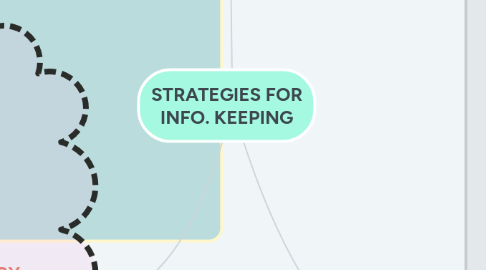
1. SENSORY MEMORY
1.1. Motivation and Emotion Reg. Strategies
1.1.1. Increase Attention
1.1.1.1. Clear your mind off distructive things and issues
1.2. Environmental Structuring
1.2.1. Decrease possible Distractions
1.2.1.1. Find a quiet environment
1.2.1.2. Turn off television
1.2.1.3. Take away all other things that might demand your attention
1.3. Cognitive and Metacognitive Strategies
1.3.1. Attend to only needed information
1.3.1.1. Activate prior knowledge
1.3.1.2. Strategically select and attend to strategies
2. LONG TERM MEMORY
2.1. Activate relevant schema
2.2. Direct attention to information based on schema
2.3. Select and encode what is relevant
2.4. Ultimately remember more
3. WORKING/SHORT TERM MEMORY
3.1. Engage in SMART Operations
3.1.1. Search and select needed information
3.1.1.1. From memory
3.1.1.2. Connect with what you know
3.1.1.3. Key ideas from seductive details
3.1.1.4. Don't fall on seductive details only
3.1.2. Monitor your understanding
3.1.2.1. Are you paying attention?
3.1.2.2. Do you understand what you are learning?
3.1.2.3. What are the discrepancies between what you know and what you are learning?
3.1.2.4. Are you wandering in your thoughts?
3.1.3. Assemble
3.1.3.1. Organize and structure information
3.1.3.1.1. Link things from different sources
3.1.3.1.2. Visualise your learning
3.1.3.1.3. Reveal gaps
3.1.3.1.4. Impose underlying structure
3.1.3.1.5. Elaborate
3.1.3.1.6. Read between lines
3.1.3.1.7. Summarize
3.1.3.1.8. Generate questions
3.1.3.1.9. Compare and contrast
3.1.3.2. Use multiple sources and connect big ideas
3.1.3.3. Search for discrepancies between your knowledge
3.1.3.4. Use concrete strategies to assemble information
3.1.4. Rehearse
3.1.4.1. Practice in different ways
3.1.4.2. Revisit concrete strategies used
3.1.5. Translate
3.1.5.1. Put things learnt on your own words
3.1.5.2. Make predictions of what could happen
3.1.5.3. Create interferences
3.1.5.4. Make reflections on what you have learnt
3.1.5.5. Create hypotheses
3.2. Rehearse
3.2.1. Repeat the words
3.2.2. Break information into chunks
3.2.3. Practice in multiple ways and try various presentations
3.3. Associate
3.3.1. Activate prior knowledge

